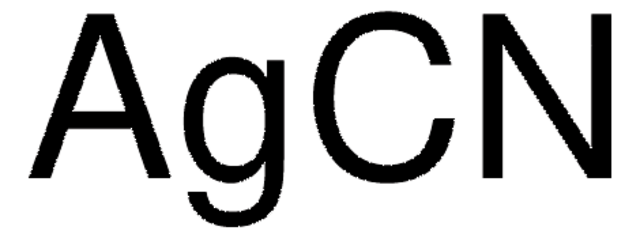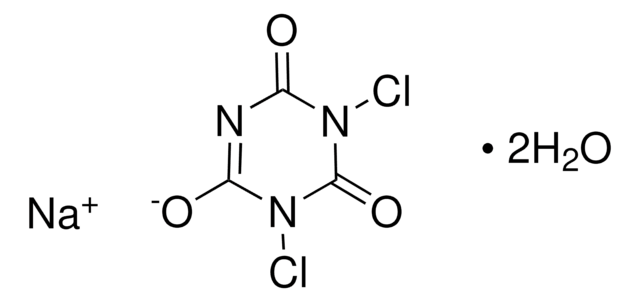379867
Potassium dicyanoaurate(I)
99.95% trace metals basis
Sinonimo/i:
Gold (I) potassium cyanide, Potassium gold cyanide
About This Item
Prodotti consigliati
Saggio
99.95% trace metals basis
Forma fisica
crystalline
Impurezze
≤550.0 ppm Trace Metal Analysis
Densità
3.45 g/mL at 25 °C (lit.)
Stringa SMILE
[K+].N#C[Au-]C#N
InChI
1S/2CN.Au.K/c2*1-2;;/q;;-1;+1
OQHPFUBKFKRHKZ-UHFFFAOYSA-N
Cerchi prodotti simili? Visita Guida al confronto tra prodotti
Descrizione generale
Applicazioni
- To prepare gold nanowire array electrodes with fast charge transfer ability.
- As a supporting electrolyte for the electrodeposition of gold in organic media.
- To prepare polypyrrole-ClO4 gas sensors with fast response time and high sensitivity to volatile organic compounds.
- In the electrochemical preparation of gold nanoparticle composites.
Avvertenze
Danger
Indicazioni di pericolo
Consigli di prudenza
Classi di pericolo
Acute Tox. 1 Dermal - Acute Tox. 2 Inhalation - Acute Tox. 2 Oral - Aquatic Acute 1 - Aquatic Chronic 1
Rischi supp
Codice della classe di stoccaggio
6.1B - Non-combustible acute toxic Cat. 1 and 2 / very toxic hazardous materials
Classe di pericolosità dell'acqua (WGK)
WGK 3
Punto d’infiammabilità (°F)
Not applicable
Punto d’infiammabilità (°C)
Not applicable
Dispositivi di protezione individuale
Eyeshields, Faceshields, Gloves, type P3 (EN 143) respirator cartridges
Scegli una delle versioni più recenti:
Possiedi già questo prodotto?
I documenti relativi ai prodotti acquistati recentemente sono disponibili nell’Archivio dei documenti.
Il team dei nostri ricercatori vanta grande esperienza in tutte le aree della ricerca quali Life Science, scienza dei materiali, sintesi chimica, cromatografia, discipline analitiche, ecc..
Contatta l'Assistenza Tecnica.




![Cyanide standard solution traceable to SRM from NIST K₂[Zn(CN)₄] in H₂O 1000 mg/l CN Certipur®](/deepweb/assets/sigmaaldrich/product/images/920/032/af45eec3-100b-4996-8eb3-c3942d441bc9/640/af45eec3-100b-4996-8eb3-c3942d441bc9.jpg)





